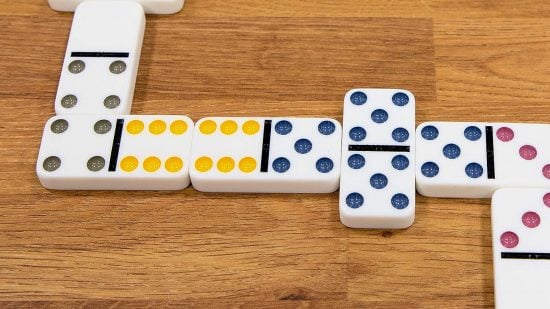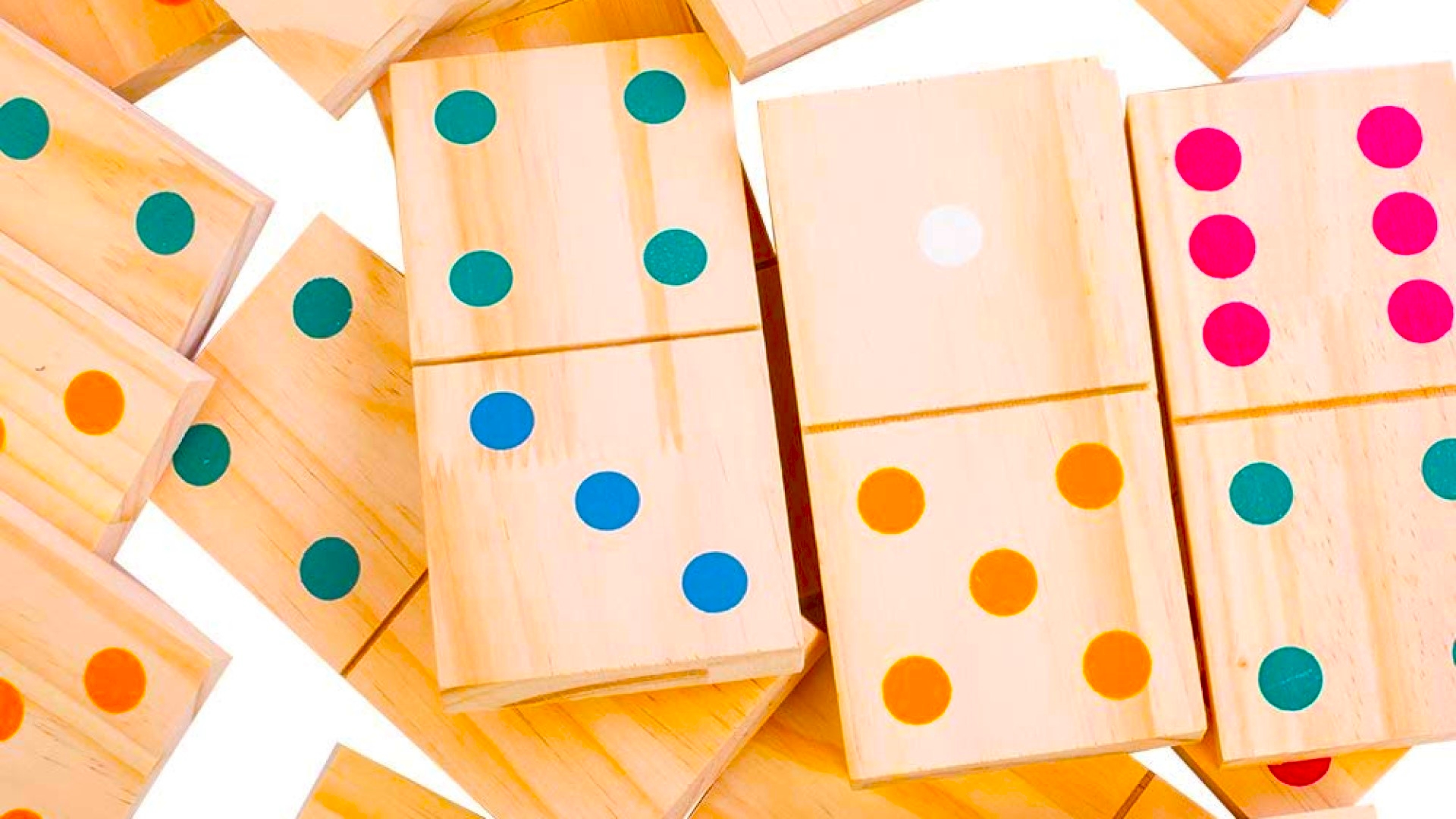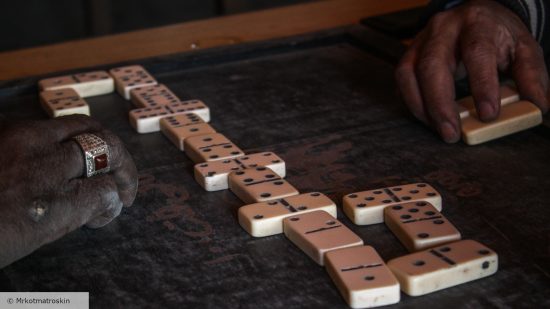Looking to learn how to play dominoes? No wonder – the best dominoes games are easy to pick up, making them an ideal pastime for players of all ages. For new and returning players, we’ve created this no-nonsense beginner’s guide to dominoes, including the key rules you need to play some of the most popular dominoes games.
For a pastime that dates as far back as the 11th century, dominoes is still widely played, rivaling the best board games of the modern age in terms of popularity. It’s the unquestioned Old Master of tile board games.
If you don’t take a shine to dominoes, we’ve still got your rainy afternoon covered. Try our guides to the best playing card games; or, if your friends fancy something sillier, check out our spicy Truth or Dare questions.
For now though, here’s how to play dominoes:
- Dominoes sets
- How to play Block dominoes
- How to play Straight dominoes
- How to play All Fives dominoes
- How to play Chicken Foot dominoes
- How to play Mexican Train dominoes
- How to play Kingdomino
Dominoes sets
Before we get into different dominoes games, you should make sure you have the best dominoes set for the job. Different sets have varying numbers of dominoes to play with, and a different maximum number of spots or ‘pips’ on the domino.
Each set is named after the highest-value domino included. The key types of dominoes sets are
- Double six dominoes
- Double nine dominoes
- Double 12 dominoes
- Double 15 dominoes
- Double 18 dominoes
Many of the games discussed below can be played using a standard set of double six dominoes, but you may need other sets to play more complex games or with additional players.
Another important thing to note is that, after centuries of dominoes games, there are bound to be different versions of even a single game variant. This means you might come across another guide that recommends playing with bigger or smaller hands or player groups – but the core rules will always be the same.
With that out of the way, let’s get you learning – here’s how to play six of the best dominoes games.
How to play Block dominoes
Block dominoes is one of the most basic games you can play with double six dominoes, and it can be played with two to four people. You start by shuffling the dominoes face-down. This is your ‘boneyard’, and you must draw seven starting dominoes to begin play.
Once the first domino is placed, players take it in turns to lay single dominoes in a line, ensuring that they match the value on one half of their domino to the one at the end of the line. Typically, a ‘double’ domino with the same value on each end can be used as a ‘spinner’. This is played at a right angle to the rest of the line, and new dominoes can be placed on all three open sides of the spinner.

If at any point you can’t play a domino, you must draw from the boneyard until you find a playable alternative. The game ends when one player lays their last domino, or the game becomes ‘blocked’ because neither player can make a legal move.
If the round ends in a block, players reveal the remaining dominoes in their hands and count the pips. The person with the lowest number wins the round.
Regardless of whether the round is blocked or a player clears their hand (called ‘dominoing’), the round winner earns points equal to the number of individual pips on the dominoes in the other players’ hands. Play repeats until you reach 100 – and crown a winner.
How to play Straight dominoes
Straight dominoes (a.k.a. Draw dominoes) starts much like a game of Block dominoes. Two to four players begin by drawing seven dominoes from a face-down boneyard, then they take it in turns to lay matching domino halves end to end.
In this variant, you score points if, at the end of your turn, all the dominoes with exposed ends add up to a multiple of five. By ‘exposed ends’, we mean any half of a domino that isn’t touching another domino.
Say, for example, that there are four exposed ends in your line of play – the initial domino played, two ends on a spinner, and the end of the main line of dominoes. If the pips on each of the exposed halves added up to 25, you would score 25 points. The aim here is to score points as you go, rather than empty your hand and count points at the end.

You still draw dominoes if you can’t play anything from your hand. Additionally, a Straight dominoes game can still become blocked. In this situation, you’d calculate the score for a blocked or dominoed round in the same way as in a Block dominoes game. However, Straight dominoes ends once a player earns 250 points, rather than just 100.
How to play All Fives dominoes
Where the last two games can be played on any set, a game of All Fives dominoes (A.K.A. Muggins) requires a set of double nine dominoes. Gameplay starts in a familiar way – two to four players draw dominoes from a shuffled boneyard. However, this time you will only draw five dominoes.
You begin laying one domino per turn just like before, and you score every time the open ended dominoes add up to a multiple of five (just like in a game of Straight dominoes). If you win a round by dominoing, you’ll calculate your score by adding up the remaining pips in each player’s hand. Blocking also works the same as in the previous two variants, and the score for a blocked round is calculated in the same way.

One thing to note with scoring: you should round any score you earn from pips to the nearest multiple of five (the game is called All Fives, after all). For example, if you score seven points, that gets rounded down to five; a score of eight would get rounded up to ten.
You’ll need to be the first person to reach 250 points to win a game of All Fives dominoes. If two players get there at the same time, the person who got the higher score is the ultimate winner.
How to play Chicken Foot dominoes
Chicken Foot dominoes is so named for its resemblance to the feet of a fowl. Each round, you compete against up to seven other players to become the first person to empty your hand. Additionally, Chicken Foot tasks you with being the lowest scorer in the game by its end – meaning every single pip counts against you.
Depending on who you ask, a game of Chicken Foot dominoes requires you to draw anywhere from five to 21 dominoes for your hand. In our experience, six dominoes in a starting hand works fine. All other dominoes go face down in the ‘chicken yard’ (it’s like a boneyard, but with chickens).
The highest double domino in the game must be laid first, so ask if anyone in your group has the double nine, or the double eight, and so on until the first domino is placed on the table.
Now everyone takes turns trying to match the double – but instead of a line, you’re trying to create a ‘double chickenfoot’, which means that the double must have six dominoes branching out of it. You can form a line (or ‘train’) once the chickenfoot is complete.

Any time a double is laid, you must complete a ‘single chickenfoot’ by laying three dominoes down with matching ends – and again, the train can’t carry on until the chickenfoot is complete. As always, you must draw from the boneyard (or chickenyard, in this case) if you can’t play a domino from your hand.
The round ends when someone plays all the dominoes in their hand or everyone is unable to play a domino. At this stage, you add up the remaining pips in your hand to calculate your points. Remember that you want to be the lowest scoring player, so emptying your hand is the goal.
Some versions of Chicken Foot dominoes also recommend a penalty of 50 points for the player who gets caught with the double zero domino.
How to play Mexican Train dominoes
A standard game of Mexican Train dominoes uses double 12 dominoes, and it accommodates up to eight players. Each player will need some sort of marker (coins are a common choice), as well as a spare marker. The aim of Mexican Train dominoes is to be the first player that places all of your dominoes.
Just like in Chicken Foot dominoes, you start by placing the highest double domino on the table. The number of dominoes drawn from the boneyard depends on how many players there are: 15 dominoes for two to four players; 12 dominoes for five to six players; and ten dominoes for seven or eight players.
As in Chicken Foot dominoes, the first round of turns has players placing dominoes in a double chickenfoot shape. However, once you place the start of a new train, this becomes your ‘personal’ train. You now keep playing dominoes from your hand to make your train as long as possible. Once you can’t make a move, the next player takes their first turn.

If you can’t add a domino to the central double to start your personal train, you add a marker to the space you would have placed a domino in that shows this is now a ‘public’ train (where any player can place their dominoes).
After the first round, everyone now takes turns placing one domino – or two if you place a double and earn an extra turn – on either their personal train, a public train, or a Mexican train. This is an additional train that can be created at any time by matching a new domino to the central double. The Mexican train is always public, and only one can be played per round.
If at any point you play a domino on your own personal train, you can remove the marker if the train was public, stopping other players from adding to it. But if, at any time, you can’t play a domino and you can’t draw a playable one from the boneyard, you must put your marker back on your train, making it public again. The game generally ends when all the doubles in the domino set are used as the starting double for a round.
How to play Kingdomino
Alright, Kingdomino is more of a dominoes-inspired game. But it’s one of the best family board games out there, so we had to include it. You can read our Kingdomino review if you’d like to know what’s so special about it. Otherwise, here’s the rules:
The tiles in Kingdomino have two sides like a regular domino, except they are covered in different types of terrain. Two to four players will match wheat fields, lakes, and mountains in their own personal five-by-five space (each tile counts as two spaces).
At the start of a game, the tiles are shuffled, and each player places a random tile as their starting piece. The rest of the dominoes become the draw pile, but some are removed depending on how many players there are (use 24 tiles for two players, 36 for three players, and 48 for four players).
A round starts with tiles drawn equal to the number of players. There are numbers on the back of the tiles, and they should be organized in ascending order (with the lowest at the top). Each player has a meeple king that represents them, which is now chosen at random to determine what order everyone goes in.
You’ll each take it in turns to choose a tile that you want in your kingdom by placing your tiny king on top. Each tile can only have one king, so whoever goes last unfortunately doesn’t have many options. When all tiles are chosen, form a new line of tiles next to it.
From the top of the tile line to the bottom, each player now takes turns placing their domino of choice, then choosing a domino from the new line of tiles. New tiles must connect to a matching terrain, and they must be discarded if there are no terrains to match with or there is no space for the tile in the five-by-five grid.
There are six rounds in two-player games and 12 in three or four-player games. At the end, points are scored for each connected area of a particular terrain. Multiply the number squares in that area by the amount of crown symbols on the terrain sections, and add these together to get your final score.
If classic board games are your thing, you don’t have to stop at dominoes. There’s always a good time to try a well-loved title, so why not learn how to play Cluedo or how to win Monopoly?
Mrkotmatroskin’s photo is used in accordance with the Creative Commons Attribution-Share Alike 4.0 International license.








